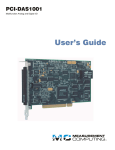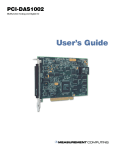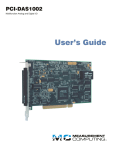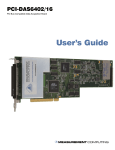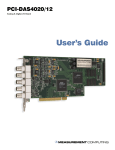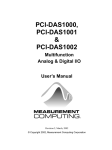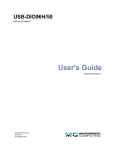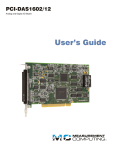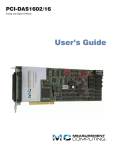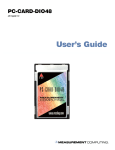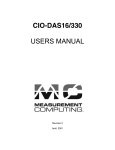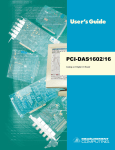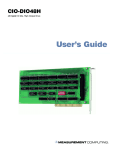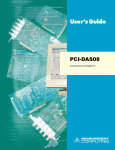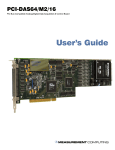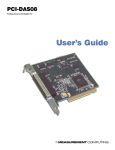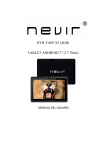Download PCI-DAS1001 User`s Manual
Transcript
PCI-DAS1001 Multifunction Analog & Digital I/O User's Guide Document Revision 2, May, 2006 © Copyright 2006, Measurement Computing Corporation Your new Measurement Computing product comes with a fantastic extra — Management committed to your satisfaction! Refer to www.mccdaq.com/execteam.html for the names, titles, and contact information of each key executive at Measurement Computing. Thank you for choosing a Measurement Computing product—and congratulations! You own the finest, and you can now enjoy the protection of the most comprehensive warranties and unmatched phone tech support. It’s the embodiment of our two missions: ! To offer the highest-quality, computer-based data acquisition, control, and GPIB hardware and software available—at the best possible price. ! To offer our customers superior post-sale support—FREE. Whether providing unrivaled telephone technical and sales support on our latest product offerings, or continuing that same first-rate support on older products and operating systems, we’re committed to you! Lifetime warranty: Every hardware product manufactured by Measurement Computing Corporation is warranted against defects in materials or workmanship for the life of the product. Products found defective are repaired or replaced promptly. Lifetime Harsh Environment Warranty®: We will replace any product manufactured by Measurement Computing Corporation that is damaged (even due to misuse) for only 50% of the current list price. I/O boards face some tough operating conditionssome more severe than the boards are designed to withstand. When a board becomes damaged, just return the unit with an order for its replacement at only 50% of the current list price. We don’t need to profit from your misfortune. By the way, we honor this warranty for any manufacturer’s board that we have a replacement for. 30 Day Money Back Guarantee: You may return any Measurement Computing Corporation product within 30 days of purchase for a full refund of the price paid for the product being returned. If you are not satisfied, or chose the wrong product by mistake, you do not have to keep it. Please call for an RMA number first. No credits or returns accepted without a copy of the original invoice. Some software products are subject to a repackaging fee. These warranties are in lieu of all other warranties, expressed or implied, including any implied warranty of merchantability or fitness for a particular application. The remedies provided herein are the buyer’s sole and exclusive remedies. Neither Measurement Computing Corporation, nor its employees shall be liable for any direct or indirect, special, incidental or consequential damage arising from the use of its products, even if Measurement Computing Corporation has been notified in advance of the possibility of such damages. HM PCI-DAS1001.doc ii Trademark and Copyright Information TracerDAQ, Universal Library, InstaCal, Harsh Environment Warranty, Measurement Computing Corporation, and the Measurement Computing logo are either trademarks or registered trademarks of Measurement Computing Corporation. Windows, Microsoft, and Visual Studio are either trademarks or registered trademarks of Microsoft Corporation LabVIEW is a trademark of National Instruments. CompactFlash is a registered trademark of SanDisk Corporation. All other trademarks are the property of their respective owners. Information furnished by Measurement Computing Corporation is believed to be accurate and reliable. However, no responsibility is assumed by Measurement Computing Corporation neither for its use; nor for any infringements of patents or other rights of third parties, which may result from its use. No license is granted by implication or otherwise under any patent or copyrights of Measurement Computing Corporation. All rights reserved. No part of this publication may be reproduced, stored in a retrieval system, or transmitted, in any form by any means, electronic, mechanical, by photocopying, recording, or otherwise without the prior written permission of Measurement Computing Corporation. Notice Measurement Computing Corporation does not authorize any Measurement Computing Corporation product for use in life support systems and/or devices without prior written consent from Measurement Computing Corporation. Life support devices/systems are devices or systems which, a) are intended for surgical implantation into the body, or b) support or sustain life and whose failure to perform can be reasonably expected to result in injury. Measurement Computing Corporation products are not designed with the components required, and are not subject to the testing required to ensure a level of reliability suitable for the treatment and diagnosis of people. iii Table of Contents Preface About this User's Guide .......................................................................................................................v What you will learn from this user's guide .........................................................................................................v Conventions in this user's guide .........................................................................................................................v Where to find more information .........................................................................................................................v Chapter 1 Introducing the PCI-DAS1001 .......................................................................................................... 1-1 Overview: PCI-DAS1001 features ................................................................................................................. 1-1 Software features ............................................................................................................................................ 1-1 PCI-DAS1001 block diagram......................................................................................................................... 1-2 Chapter 2 Installing the PCI-DAS1001 .............................................................................................................. 2-1 What is included with your PCI-DAS1001 .................................................................................................... 2-1 Hardware ....................................................................................................................................................................... 2-1 Additional documentation.............................................................................................................................................. 2-1 Optional components ..................................................................................................................................................... 2-1 Unpacking the PCI-DAS1001 ........................................................................................................................ 2-2 Installing the software .................................................................................................................................... 2-2 Installing the hardware ................................................................................................................................... 2-2 Configuring the hardware ............................................................................................................................... 2-2 Differential input mode.................................................................................................................................................. 2-3 Single-ended input mode ............................................................................................................................................... 2-3 Connecting the board for I/O operations ........................................................................................................ 2-3 Connectors, cables – main I/O connector....................................................................................................................... 2-3 Pinout – main I/O connector .......................................................................................................................................... 2-4 Cables ............................................................................................................................................................................ 2-6 Field wiring and signal termination ............................................................................................................................... 2-6 Chapter 3 Programming and Developing Applications .................................................................................. 3-1 Programming languages ................................................................................................................................. 3-1 Packaged applications programs..................................................................................................................... 3-1 Register-level programming ........................................................................................................................... 3-1 Chapter 4 Calibrating the Board........................................................................................................................ 4-1 Introduction .................................................................................................................................................... 4-1 Calibration theory ........................................................................................................................................... 4-1 Chapter 5 Specifications.................................................................................................................................... 5-1 Analog input ................................................................................................................................................... 5-1 Analog output ................................................................................................................................................. 5-2 Digital input/output......................................................................................................................................... 5-2 Counter section ............................................................................................................................................... 5-3 Power consumption ........................................................................................................................................ 5-3 Main connector and pin out ............................................................................................................................ 5-4 8-channel differential mode pin out ............................................................................................................................... 5-5 16-channel single-ended mode pin out........................................................................................................................... 5-6 iv Preface About this User's Guide What you will learn from this user's guide This user's guide explains how to install, configure, and use the PCI-DAS1001 so that you get the most out of its analog, digital, and timing I/O features. This user's guide also refers you to related documents available on our web site, and to technical support resources that can also help you get the most out of your board. Conventions in this user's guide For more information on … Text presented in a box signifies additional information and helpful hints related to the subject matter you are reading. Caution! Shaded caution statements present information to help you avoid injuring yourself and others, damaging your hardware, or losing your data. <#:#> Angle brackets that enclose numbers separated by a colon signify a range of numbers, such as those assigned to registers, bit settings, etc. bold text Bold text is used for the names of objects on the screen, such as buttons, text boxes, and check boxes. For example: 1. Insert the disk or CD and click the OK button. italic text Italic text is used for the names of manuals and help topic titles, and to emphasize a word or phrase. For example: The InstaCal® installation procedure is explained in the Quick Start Guide. Never touch the exposed pins or circuit connections on the board. Where to find more information The following electronic documents provide relevant information to the operation of your PCI-DAS1001. ! ! ! ! ! ! MCC's Specifications: PCI-DAS1001 (the PDF version of the Electrical Specification Chapter in this guide) is available on our web site at www.mccdaq.com/pdfs/PCI-DAS1001.pdf. MCC's Quick Start Guide is available on our web site at www.mccdaq.com/PDFmanuals/DAQ-Software-Quick-Start.pdf. MCC's Guide to Signal Connections is available on our web site at www.mccdaq.com/signals/signals.pdf. MCC's Universal Library User's Guide is available on our web site at www.mccdaq.com/PDFmanuals/sm-ul-user-guide.pdf. MCC's Universal Library Function Reference is available on our web site at www.mccdaq.com/PDFmanuals/sm-ul-functions.pdf. MCC's Universal Library for LabVIEW™ User’s Guide is available on our web site at www.mccdaq.com/PDFmanuals/SM-UL-LabVIEW.pdf. PCI-DAS1001 User's Manual (this document) is also available on our web site at www.mccdaq.com/PDFmanuals/PCI-DAS1001.pdf. v Chapter 1 Introducing the PCI-DAS1001 Overview: PCI-DAS1001 features This manual explains how to install and use the PCI-DAS1001. This board is a multifunction analog and digital I/O board designed for the PCI bus. The PCI-DAS1001 provides either 16 single-ended or eight differential analog inputs. Input ranges are software-selectable as either bipolar or unipolar. Analog input ranges for the PCI-DAS1001 board are: ! ! Bipolar: ±10 V, ±1.0 V, ±0.1 V, ±0.01 V Unipolar: 0 to 10 V, 0 to 1.0 V, 0 to 0.1V, 0 to 0.01 V The PCI-DAS1001 provides a 150 kHz sample rate. The PCI-DAS1001 also provides two channels of 12-bit analog output. Analog output ranges are ±10 V and ±5 V (bipolar) and 0-10 V, 0-5 V (unipolar). The PCI-DAS1001 offers 24-bits of parallel, digital I/O (two 8-bit ports and two 4-bit ports). You can configure each port independently as input or output. This board has an 82C54 counter chip which has three user-accessible 16-bit counters. Clock, gate, and output signals from two of three counters are available on a 100-pin connector. The third counter is used internally. The PCI-DAS1001 is fully plug-and-play. All addresses and interrupt channels are set with software. Software features For information on the features of InstaCal and the other software included with your PCI-DAS1001, refer to the Quick Start Guide that shipped with your device. The Quick Start Guide is also available in PDF at www.mccdaq.com/PDFmanuals/DAQ-Software-Quick-Start.pdf. Check www.mccdaq.com/download.htm for the latest software version or versions of the software supported under less commonly used operating systems. 1-1 PCI-DAS1001 User's Manual Introducing the PCI-DAS1001 PCI-DAS1001 block diagram PCI-DAS1001 functions are illustrated in the block diagram shown here. Figure 1-1. PCI-DAS1001 functional block diagram 1-2 Chapter 2 Installing the PCI-DAS1001 What is included with your PCI-DAS1001 As you unpack your board, make sure each of the items shown below is included: Hardware ! PCI-DAS1001 Additional documentation In addition to this hardware user's guide, you should also receive the Quick Start Guide (available in PDF at www.mccdaq.com/PDFmanuals/DAQ-Software-Quick-Start.pdf). This booklet supplies a brief description of the software you received with your PCI-DAS1001 and information regarding installation of that software. Please read this booklet completely before installing any software or hardware. Optional components If you ordered any of the following products with your board, they should be included with your shipment. ! C100FF-x cable ! Signal termination and conditioning accessories MCC provides signal termination and conditioning products for use with the PCI-DAS1001. Refer to the "Field wiring and signal termination" section for a complete list of compatible accessory products. 2-1 PCI-DAS1001 User's Manual Installing the PCI-DAS1001 Unpacking the PCI-DAS1001 As with any electronic device, you should take care while handling to avoid damage from static electricity. Before removing the PCI-DAS1001 from its packaging, ground yourself using a wrist strap or by simply touching the computer chassis or other grounded object to eliminate any stored static charge. If any components are missing or damaged, notify Measurement Computing Corporation immediately by phone, fax, or e-mail: ! ! ! Phone: 508-946-5100 and follow the instructions for reaching Tech Support. Fax: 508-946-9500 to the attention of Tech Support Email: [email protected] Installing the software Refer to the Quick Start Guide for instructions on installing the software on the Measurement Computing Data Acquisition Software CD. This booklet is available in PDF at www.mccdaq.com/PDFmanuals/DAQ-SoftwareQuick-Start.pdf. Installing the hardware The PCI-DAS1001 board is completely plug-and-play. There are no switches or jumpers to set on the board. Configuration is controlled by your system's BIOS. To install your board, follow the steps below. Install the MCC DAQ software before you install your board The driver needed to run your board is installed with the MCC DAQ software. Therefore, you need to install the MCC DAQ software before you install your board. Refer to the Quick Start Guide for instructions on installing the software. 1. Turn your computer off, open it up, and insert your board into an available PCI slot. 2. Close your computer and turn it on. If you are using an operating system with support for plug-and-play (such as Windows 2000 or Windows XP), a dialog box pops up as the system loads indicating that new hardware has been detected. If the information file for this board is not already loaded onto your PC, you will be prompted for the disk containing this file. The MCC DAQ software contains this file. If required, insert the Measurement Computing Data Acquisition Software CD and click OK. 3. To test your installation and configure your board, run the InstaCal utility you installed in the previous section. Refer to the Quick Start Guide that came with your board www.mccdaq.com/PDFmanuals/DAQSoftware-Quick-Start.pdf for information on how to initially set up and load InstaCal. Allow your computer to warm up for at least 15 minutes before acquiring data with this board. The high speed components used on the board generates heat, and it takes this amount of time for a board to reach steady state if it has been powered off for a significant amount of time. Configuring the hardware All hardware configuration options on the PCI-DAS1001 are software controlled. You can select some of the configuration options using InstaCal, such as the analog input configuration (16 single-ended or eight differential channels), and the source for the two independent counters. Once selected, any program that uses the Universal Library will initialize the hardware according to these selections. Following is an overview of the available hardware configuration options for this board. There is additional general information regarding analog signal connection and configuration in the Guide to Signal Connections (available on our web site at www.mccdaq.com/signals/signals.pdf). 2-2 PCI-DAS1001 User's Manual Installing the PCI-DAS1001 Differential input mode When all channels are configured for differential input mode, eight analog input channels are available. In this mode, the input signal is measured with respect to the low input. The input signal is delivered through three wires: ! ! ! The wire carrying the signal to be measured connects to CH# IN HI. The wire carrying the reference signal connects to CH# IN LO. The third wire, typically a system ground, connects to LLGND. Single-ended input mode When all channels are configured for single-ended input mode, 16 analog input channels are available. In this mode, the input signal is referenced to the board's signal ground (LLGND). The input signal is delivered through two wires: ! ! The wire carrying the signal to be measured connects to CH# IN HI. The second wire connects to LLGND. Connecting the board for I/O operations Connectors, cables – main I/O connector Table 2-1 lists the board connectors, applicable cables, and compatible accessory boards for the PCI-DAS1001. Table 2-1 Board Connectors, cables, accessory equipment Connector type Compatible cables Compatible accessory products (with the C100FF-x cable) 100-pin high density Robinson Nugent connector C100FF-x, unshielded ribbon cable. x = length in feet (Figure 2-1) ISO-RACK16/P ISO-DA02/P CIO-ERB08 (DADP-5037 adaptor required *) CIO-ERB24 (DADP-5037 adaptor required *) SSR-RACK08 (DADP-5037 adaptor required *) SSR-RACK24 (DADP-5037 adaptor required *) BNC-16SE BNC-16DI CIO-MINI50 (2 required) CIO-TERM100 (1 required) SCB-50 (1 required) * Details on the DADP-5037 adaptor board are available on our web site at www.mccdaq.com/cbicatalog/cbiproduct.asp?dept_id=103&pf_id=1381. 2-3 PCI-DAS1001 User's Manual Installing the PCI-DAS1001 Pinout – main I/O connector Table 2-2. 8-channel differential mode Signal Name GND N/C N/C N/C N/C A/D Int. Pacer Output N/C N/C PC -12V PC GND PC +12V PC GND N/C CTR5 OUT CTR5 GATE CTR5 CLK N/C N/C CTR6 OUT CTR6 GATE CTR6 CLK N/C N/C N/C N/C N/C FIRSTPORTC Bit 7 FIRSTPORTC Bit 6 FIRSTPORTC Bit 5 FIRSTPORTC Bit 4 FIRSTPORTC Bit 3 FIRSTPORTC Bit 2 FIRSTPORTC Bit 1 FIRSTPORTC Bit 0 FIRSTPORTB Bit 7 FIRSTPORTB Bit 6 FIRSTPORTB Bit 5 FIRSTPORTB Bit 4 FIRSTPORTB Bit 3 FIRSTPORTB Bit 2 FIRSTPORTB Bit 1 FIRSTPORTB Bit 0 FIRSTPORTA Bit 7 FIRSTPORTA Bit 6 FIRSTPORTA Bit 5 FIRSTPORTA Bit 4 FIRSTPORTA Bit 3 FIRSTPORTA Bit 2 FIRSTPORTA Bit 1 FIRSTPORTA Bit 0 PCI slot Pin 100 99 98 97 96 95 94 93 92 91 90 89 88 87 86 85 84 83 82 81 80 79 78 77 76 75 74 73 72 71 70 69 68 67 66 65 64 63 62 61 60 59 58 57 56 55 54 53 52 51 •• •• •• •• •• •• •• •• •• •• •• •• •• •• •• •• •• •• •• •• •• •• •• •• •• •• •• •• •• •• •• •• •• •• •• •• •• •• •• •• •• •• •• •• •• •• •• •• •• •• ↓ 2-4 Pin 50 49 48 47 46 45 44 43 42 41 40 39 38 37 36 35 34 33 32 31 30 29 28 27 26 25 24 23 22 21 20 19 18 17 16 15 14 13 12 11 10 9 8 7 6 5 4 3 2 1 Signal Name GND N/C PC +5V N/C N/C A/D External Trigger N/C N/C A/D External Pacer CTR4 OUT CTR4 GATE CTR4 CLK D/A OUT 1 D/A GND 1 D/A OUT 0 D/A GND 0 N/C N/C N/C N/C N/C N/C N/C N/C N/C N/C N/C N/C N/C N/C N/C N/C LLGND CH7 IN LO CH7 IN HI CH6 IN LO CH6 IN HI CH5 IN LO CH5 IN HI CH4 IN LO CH4 IN HI CH3 IN LO CH3 IN HI CH2 IN LO CH2 IN HI CH1 IN LO CH1 IN HI CH0 IN LO CH0 IN HI LLGND PCI-DAS1001 User's Manual Installing the PCI-DAS1001 Table 2-3. 16-channel single-ended mode Signal Name GND N/C N/C N/C N/C A/D Int. Pacer Output N/C N/C PC -12V PC GND PC +12V PC GND N/C CTR5 OUT CTR5 GATE CTR5 CLK N/C N/C CTR6 OUT CTR6 GATE CTR6 CLK N/C N/C N/C N/C N/C FIRSTPORTC Bit 7 FIRSTPORTC Bit 6 FIRSTPORTC Bit 5 FIRSTPORTC Bit 4 FIRSTPORTC Bit 3 FIRSTPORTC Bit 2 FIRSTPORTC Bit 1 FIRSTPORTC Bit 0 FIRSTPORTB Bit 7 FIRSTPORTB Bit 6 FIRSTPORTB Bit 5 FIRSTPORTB Bit 4 FIRSTPORTB Bit 3 FIRSTPORTB Bit 2 FIRSTPORTB Bit 1 FIRSTPORTB Bit 0 FIRSTPORTA Bit 7 FIRSTPORTA Bit 6 FIRSTPORTA Bit 5 FIRSTPORTA Bit 4 FIRSTPORTA Bit 3 FIRSTPORTA Bit 2 FIRSTPORTA Bit 1 FIRSTPORTA Bit 0 PCI slot Pin 100 99 98 97 96 95 94 93 92 91 90 89 88 87 86 85 84 83 82 81 80 79 78 77 76 75 74 73 72 71 70 69 68 67 66 65 64 63 62 61 60 59 58 57 56 55 54 53 52 51 •• •• •• •• •• •• •• •• •• •• •• •• •• •• •• •• •• •• •• •• •• •• •• •• •• •• •• •• •• •• •• •• •• •• •• •• •• •• •• •• •• •• •• •• •• •• •• •• •• •• ↓ 2-5 Pin 50 49 48 47 46 45 44 43 42 41 40 39 38 37 36 35 34 33 32 31 30 29 28 27 26 25 24 23 22 21 20 19 18 17 16 15 14 13 12 11 10 9 8 7 6 5 4 3 2 1 Signal Name GND N/C PC +5V N/C N/C A/D External Trigger In N/C N/C A/D External Pacer CTR4 OUT CTR4 GATE CTR4 CLK D/A OUT 1 D/A GND 1 D/A OUT 0 D/A GND 0 N/C N/C N/C N/C N/C N/C N/C N/C N/C N/C N/C N/C N/C N/C N/C N/C LLGND CH15 IN CH7 IN CH14 IN CH6 IN CH13 IN CH5 IN CH12 IN CH4 IN CH11 IN CH3 IN CH10 IN CH2 IN CH9 IN CH1 IN CH8 IN CH0 IN LLGND PCI-DAS1001 User's Manual Installing the PCI-DAS1001 Cables Cable is labeled “Pins 1-50”. 50 49 50 1 2 Key 100 The red stripe identifies pin # 1 99 100 1 51 Key 51 Cable is labeled “Pins 51-100”. 52 The red stripe identifies pin # 51 Figure 2-1. C100FF-x cable Field wiring and signal termination The following MCC screw terminal and signal conditioning boards are compatible with the PCI-DAS1001: ! ! ! ! ! ! ! ! ! ! SCB-50 – 50-conductor, shielded signal connection box. Details on this product are available on our web site at www.mccdaq.com/cbicatalog/cbiproduct.asp?dept_id=196&pf_id=1168. CIO-MINI50 – 50-pin universal screw terminal accessory. Details on this product are available on our web site at www.mccdaq.com/cbicatalog/cbiproduct.asp?dept_id=102&pf_id=258. ISO-RACK16/P – 16-channel isolation module mounting rack. Details on this product are available on our web site at www.mccdaq.com/cbicatalog/cbiproduct.asp?dept_id=127&pf_id=1111. ISO-DA02/P – Two-channel 5B module rack. Details on this product are available on our web site at www.mccdaq.com/cbicatalog/cbiproduct.asp?dept_id=128&pf_id=710. BNC-16SE – 16-channel single-ended BNC connector box. Details on this product are available on our web site at www.mccdaq.com/cbicatalog/cbiproduct.asp?dept_id=101&pf_id=713. BNC-16DI – Eight-channel differential BNC connector box. Details on this product are available on our web site at www.mccdaq.com/cbicatalog/cbiproduct.asp?dept_id=101&pf_id=714. SSR-RACK24* – 24-position solid state relay rack. Details on this product are available on our web site at www.mccdaq.com/cbicatalog/cbiproduct.asp?dept_id=122&pf_id=1193. SSR-RACK08* – Eight-channel solid state relay rack. Details on this product are available on our web site at www.mccdaq.com/cbicatalog/cbiproduct.asp?dept_id=122&pf_id=620. CIO-ERB24* – 24-channel electromechanical relay accessory for digital I/O boards. Details on this product are available on our web site at www.mccdaq.com/cbicatalog/cbiproduct.asp?dept_id=123&pf_id=241. CIO-ERB08* – Eight-channel electromechanical relay accessory for digital I/O boards. Details on this product are available on our web site at www.mccdaq.com/cbicatalog/cbiproduct.asp?dept_id=123&pf_id=241. * The SSR-RACK24, SSR-RACK08, CIO-ERB24, and CIO-ERB08 boards require the DADP-5037 PCI-DASto-37-pin SSR and ERB adapter. Details on this product are available on our web site at www.mccdaq.com/cbicatalog/cbiproduct.asp?dept_id=103&pf_id=1381 2-6 Chapter 3 Programming and Developing Applications After following the installation instructions in Chapter 2, your board should now be installed and ready for use. Although the board is part of the larger DAS family, in general there may be no correspondence among registers for different boards. Software written at the register level for other DAS models will not function correctly with your board. Programming languages Measurement Computing’s Universal Library® provides access to board functions from a variety of Windows programming languages. If you are planning to write programs, or would like to run the example programs for Visual Basic or any other language, please refer to the Universal Library User's Guide (available on our web site at www.mccdaq.com/PDFmanuals/sm-ul-user-guide.pdf). Packaged applications programs Many packaged application programs, such as SoftWIRE and HP-VEE™, now have drivers for your board. If the package you own does not have drivers for the board, please fax or e-mail the package name and the revision number from the install disks. We will research the package for you and advise how to obtain drivers. Some application drivers are included with the Universal Library package, but not with the application package. If you have purchased an application package directly from the software vendor, you may need to purchase our Universal Library and drivers. Please contact us by phone, fax, or e-mail: ! ! ! Phone: 508-946-5100 and follow the instructions for reaching Tech Support. Fax: 508-946-9500 to the attention of Tech Support Email: [email protected] Register-level programming You should use the Universal Library or one of the packaged application programs mentioned above to control your board. Only experienced programmers should perform register-level programming. If you need to program at the register level in your application, refer to the Register Map for the PCI-DAS1001 Series (available at www.mccdaq.com/registermaps/RegMapSTC1000.pdf). 3-1 Chapter 4 Calibrating the Board Introduction Calibrate the board using the InstaCal utility after the board has fully warmed up. The recommended warm-up time is 15 minutes. For best results, calibrate the board immediately before making critical measurements. The high resolution analog components on the board are sensitive to temperature. Pre-measurement calibration ensures that your board is operating at optimum calibration values. Calibration theory PCI-DAS1001 series boards are shipped fully calibrated from the factory with calibration coefficients stored in nvRAM. When using Universal Library at run time, these calibration factors are loaded into system memory and are automatically retrieved each time a different DAC/ADC range is specified. The analog input circuits are calibrated for both offset and gain (Figure 4-1). ! ! Offset calibration for the analog input is performed directly on the input amplifier (PGIA) with coarse and fine trim DACs acting on the amplifier. For input gain calibration, a precision calibration reference is used with coarse and fine trim DACs acting on the ADC. Analog In Trim DAC Coarse Variable Gain PGIA A/D Pre-Gain Offset Trim DAC Fine Figure 4-1. Analog input circuit calibration The analog outputs are calibrated for both offset and gain (Figure 4-2). This circuit is duplicated for both DAC0 and DAC1. ! ! Offset adjustments are made in the output buffer section. The tuning range of this adjustment allows for max DAC and output buffer offsets. Gain calibration is performed via DAC reference adjustments. Analog Out D/A Ref Trim DAC Coarse Gain Adjust Trim DAC Offset Adjust Trim DAC Fine Figure 4-2. Analog output circuit calibration 4-1 Chapter 5 Specifications Typical for 25 °C unless otherwise specified. Specifications in italic text are guaranteed by design. Analog input Table 1. Analog input specifications Parameter Specification A/D converter type Resolution Number of channels Input ranges 7800 12 bits 8 differential or 16 single-ended, software selectable ±10 V, ±1 V, ±0.1 V, ±0.01 V, 0 to 10 V, 0 to 1 V, 0 to 0.1 V, 0 to 0.01 V. Fully programmable Unipolar/bipolar, software selectable Programmable: internal counter or external source (A/D External Pacer, positive or negative edge selectable by software), or software polled Software selectable option, rate = 6.67µs External digital (A/D External Trigger) Digital: Software enabled, rising edge, hardware trigger Pre-trigger: Unlimited pre- and post-trigger samples. Total # of samples must be > 512. From 1024 sample FIFO via REPINSW, interrupt or software polled 3 µs 150 kHz ±1.5 LSB ±0.75 LSB ±0.5 LSB typ, ±1.5 LSB max 0.01 V range: ± 0.4% of reading, max All other ranges: ± 0.02% of reading, max 12 bits Auto-calibration, calibration factors for each range stored on board in non-volatile RAM ±6 ppm/°C ±1 ppm/°C ±10 V 70 dB 200 nA 10 MOhms, min ±35 V Polarity A/D pacing Burst mode A/D trigger sources A/D triggering modes Data transfer A/D conversion time Throughput Relative accuracy Differential linearity error Integral linearity error Gain error (relative to calibration reference) No missing codes guaranteed Calibration Gain drift (A/D specs) Zero drift (A/D specs) Common mode range CMRR @ 60 Hz Input leakage current Input impedance Absolute maximum input voltage Noise distribution Rate = 1-150 kHz, average # bins 10 V ranges: 3 bins 1 V ranges: 4 bins 0.1 V ranges: 10 bins Bipolar 0.01 V range: 20 bins Unipolar 0.01 V range: 32 bins 5-1 PCI-DAS1001 User's Manual Specifications Analog output Table 2. Analog output specifications Parameter Specification D/A type Resolution Number of channels Output ranges AD7847AR 12 bits 2 ±10 V, ±5 V, 0 to 5 V, 0 to 10 V. Each channel independently programmable. Software Programmed I/O ±600 µV max, all ranges (calibrated) ±0.02% FSR max (calibrated) ±1 LSB max ±1 LSB max 12 bits ±2 ppm/°C max ±5 ppm/°C max ±5 ppm/°C max PC dependent 4 µs typ 7 V/µS ±5 mA min 25 mA indefinite DC 0.1 Ohms max Power up and reset, all DACs cleared to 0 V, ±200 mV D/A pacing Data transfer Offset error Gain error Differential nonlinearity Integral nonlinearity Monotonicity D/A gain drift D/A bipolar offset drift D/A unipolar offset drift Throughput Settling time (to 0.01% of 10 V step) Slew rate Current drive Output short-circuit duration Output coupling Amp output impedance Miscellaneous Digital input/output Table 3. DIO specifications Parameter Specification Digital type Configuration Number of channels Output high Output low Input high Input low Power-up / reset state Interrupts Interrupt enable Interrupt sources 82C55A 2 banks of 8, 2 banks of 4, programmable by bank as input or output 24 I/O (FIRSTPORTA 0 through FIRSTPORTC 7) 3.0 V, min @ -2.5 mA 0.4 V, max @ 2.5 mA 2.0 V, min, +5.5 V absolute, max 0.8 V, max, -0.5 V absolute, min Input mode (high impedance) INTA# - mapped to IRQn via PCI BIOS at boot-time Programmable Residual counter, end-of-channel-scan, AD-FIFO-not-empty, AD-FIFOhalf-full 5-2 PCI-DAS1001 User's Manual Specifications Counter section Table 4. Counter specifications Parameter Specification Counter type Configuration 82C54A: Counter 0 - ADC residual sample counter 82C54 Two 82C54 devices. 3 down counters per 82C54, 16 bits each ! Source: ADC Clock. ! Gate: Internal programmable source. ! Output: End-of-Acquisition interrupt. ! Source: 10 MHz oscillator ! Gate: tied to counter 2 gate, programmable source. ! Output: chained to counter 2 clock. ! Source: counter 1 output. ! Gate: Tied to counter 1 gate, programmable source. ! Output: ADC pacer clock (if software selected), available at user connector. ! Source: ADC clock ! Gate: external trigger ! Output: End-of-Acquisition interrupt ! Source: User input at 100-pin connector (CLK4) or internal 10 MHz (software selectable) ! Gate: user input at 100-pin connector (GATE4) ! Output: available at 100-pin connector (OUT4) ! Source: user input at 100-pin connector (CLK5) ! Gate: user input at 100-pin connector (GATE5) ! Output: available at 100-pin connector (OUT5) ! Source: user input at 100-pin connector (CLK6) ! Gate: user input at 100-pin connector (GATE6) ! Output: available at 100-pin connector (OUT6) 10 MHz max 30 ns min 50 ns min 50 ns min 50 ns min 0.8 V max 2.0 V min 0.4 V max 3.0 V min Counter 1 - ADC pacer lower divider Counter 2 - ADC pacer upper divider 82C54B: Counter 0 - pretrigger mode Counter 0 - user counter 4 (when in non-pretrigger mode) Counter 1 - user counter 5 Counter 2 - user counter 6 Clock input frequency High pulse width (clock input) Low pulse width (clock input) Gate width high Gate width low Input low voltage Input high voltage Output low voltage Output high voltage Power consumption Table 5. Power consumption specifications Parameter Specification +5 V operating (A/D converting to FIFO) 0.8 A typical, 1.0 A max 5-3 PCI-DAS1001 User's Manual Specifications Environmental Table 6. Environmental specifications Parameter Specification Operating temperature range Storage temperature range Humidity 0 to 70 °C -40 to 100 °C 0 to 90% non-condensing Main connector and pin out Connector type Compatible cable Compatible accessory products (with C100FF-x cable) 100-pin high density Robinson Nugent C100FF-x, unshielded ribbon cable. x = length in feet BNC-16SE ISO-RACK16/P BNC-16DI ISO-DA02/P CIO-MINI50 (2 required) CIO-ERB24 (DADP-5037 adaptor required) CIO-TERM100 (1 required) CIO-SERB24 (DADP-5037 adaptor required) SCB-50 (1 required) SSR-RACK24 (DADP-5037 adaptor required) 5-4 PCI-DAS1001 User's Manual Specifications 8-channel differential mode pin out Pin 1 2 3 4 5 6 7 8 9 10 11 12 13 14 15 16 17 18 19 20 21 22 23 24 25 26 27 28 29 30 31 32 33 34 35 36 37 38 39 40 41 42 43 44 45 46 47 48 49 50 Signal Name LLGND CH0 IN HI CH0 IN LO CH1 IN HI CH1 IN LO CH2 IN HI CH2 IN LO CH3 IN HI CH3 IN LO CH4 IN HI CH4 IN LO CH5 IN HI CH5 IN LO CH6 IN HI CH6 IN LO CH7 IN HI CH7 IN LO LLGND N/C N/C N/C N/C N/C N/C N/C N/C N/C N/C N/C N/C N/C N/C N/C N/C D/A GND 0 D/A OUT 0 D/A GND 1 D/A OUT 1 CTR4 CLK CTR4 GATE CTR4 OUT A/D EXTERNAL PACER N/C N/C A/D EXTERNAL TRIGGER IN N/C N/C PC +5V N/C GND Pin 51 52 53 54 55 56 57 58 59 60 61 62 63 64 65 66 67 68 69 70 71 72 73 74 75 76 77 78 79 80 81 82 83 84 85 86 87 88 89 90 91 92 93 94 95 96 97 98 99 100 5-5 Signal Name FIRSTPORTA Bit 0 FIRSTPORTA Bit 1 FIRSTPORTA Bit 2 FIRSTPORTA Bit 3 FIRSTPORTA Bit 4 FIRSTPORTA Bit 5 FIRSTPORTA Bit 6 FIRSTPORTA Bit 7 FIRSTPORTB Bit 0 FIRSTPORTB Bit 1 FIRSTPORTB Bit 2 FIRSTPORTB Bit 3 FIRSTPORTB Bit 4 FIRSTPORTB Bit 5 FIRSTPORTB Bit 6 FIRSTPORTB Bit 7 FIRSTPORTC Bit 0 FIRSTPORTC Bit 1 FIRSTPORTC Bit 2 FIRSTPORTC Bit 3 FIRSTPORTC Bit 4 FIRSTPORTC Bit 5 FIRSTPORTC Bit 6 FIRSTPORTC Bit 7 N/C N/C N/C N/C N/C CTR6 CLK CTR6 GATE CTR6 OUT N/C N/C CTR5 CLK CTR5 GATE CTR5 OUT N/C GND +12V GND -12V N/C N/C A/D INTERNAL PACER OUTPUT N/C N/C N/C N/C GND PCI-DAS1001 User's Manual Specifications 16-channel single-ended mode pin out Pin 1 2 3 4 5 6 7 8 9 10 11 12 13 14 15 16 17 18 19 20 21 22 23 24 25 26 27 28 29 30 31 32 33 34 35 36 37 38 39 40 41 42 43 44 45 46 47 48 49 50 Signal Name LLGND CH0 IN CH8 IN CH1 IN CH9 IN CH2 IN CH10 IN CH3 IN CH11 IN CH4 IN CH12 IN CH5 IN CH13 IN CH6 IN CH14 IN CH7 IN CH15 IN LLGND N/C N/C N/C N/C N/C N/C N/C N/C N/C N/C N/C N/C N/C N/C N/C N/C D/A GND 0 D/A OUT 0 D/A GND 1 D/A OUT 1 CTR4 CLK CTR4 GATE CTR4 OUT A/D EXTERNAL PACER N/C N/C A/D EXTERNAL TRIGGER IN N/C N/C PC +5V N/C GND Pin 51 52 53 54 55 56 57 58 59 60 61 62 63 64 65 66 67 68 69 70 71 72 73 74 75 76 77 78 79 80 81 82 83 84 85 86 87 88 89 90 91 92 93 94 95 96 97 98 99 100 5-6 Signal Name FIRSTPORTA Bit 0 FIRSTPORTA Bit 1 FIRSTPORTA Bit 2 FIRSTPORTA Bit 3 FIRSTPORTA Bit 4 FIRSTPORTA Bit 5 FIRSTPORTA Bit 6 FIRSTPORTA Bit 7 FIRSTPORTB Bit 0 FIRSTPORTB Bit 1 FIRSTPORTB Bit 2 FIRSTPORTB Bit 3 FIRSTPORTB Bit 4 FIRSTPORTB Bit 5 FIRSTPORTB Bit 6 FIRSTPORTB Bit 7 FIRSTPORTC Bit 0 FIRSTPORTC Bit 1 FIRSTPORTC Bit 2 FIRSTPORTC Bit 3 FIRSTPORTC Bit 4 FIRSTPORTC Bit 5 FIRSTPORTC Bit 6 FIRSTPORTC Bit 7 N/C N/C N/C N/C N/C CTR6 CLK CTR6 GATE CTR6 OUT N/C N/C CTR5 CLK CTR5 GATE CTR5 OUT N/C GND +12V GND -12V N/C N/C A/D INTERNAL PACER OUTPUT N/C N/C N/C N/C GND Declaration of Conformity Manufacturer: Address: Category: Measurement Computing Corporation 10 Commerce Way Suite 1008 Norton, MA 02766 USA Electrical equipment for measurement, control and laboratory use. Measurement Computing Corporation declares under sole responsibility that the product PCI-DAS1001 to which this declaration relates is in conformity with the relevant provisions of the following standards or other documents: EU EMC Directive 89/336/EEC: Electromagnetic Compatibility, EN55022 (1995), EN55024 (1998) Emissions: Group 1, Class B ! EN55022 (1995): Radiated and Conducted emissions. Immunity: EN55024 ! ! ! ! ! ! ! EN61000-4-2 (1995): Electrostatic Discharge immunity, Criteria A. EN61000-4-3 (1997): Radiated Electromagnetic Field immunity Criteria A. EN61000-4-4 (1995): Electric Fast Transient Burst immunity Criteria A. EN61000-4-5 (1995): Surge immunity Criteria A. EN61000-4-6 (1996): Radio Frequency Common Mode immunity Criteria A. EN61000-4-8 (1994): Power Frequency Magnetic Field immunity Criteria A. EN61000-4-11 (1994): Voltage Dip and Interrupt immunity Criteria A. Declaration of Conformity based on tests conducted by Chomerics Test Services, Woburn, MA 01801, USA in September, 2001. Test records are outlined in Chomerics Test Report #EMI3053.01. We hereby declare that the equipment specified conforms to the above Directives and Standards. Carl Haapaoja, Director of Quality Assurance Measurement Computing Corporation 10 Commerce Way Suite 1008 Norton, Massachusetts 02766 (508) 946-5100 Fax: (508) 946-9500 E-mail: [email protected] www.mccdaq.com
























